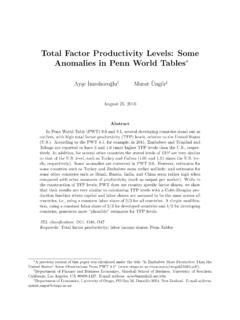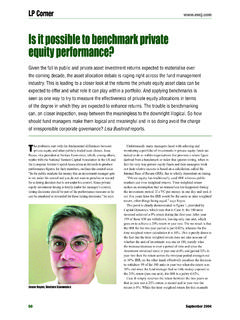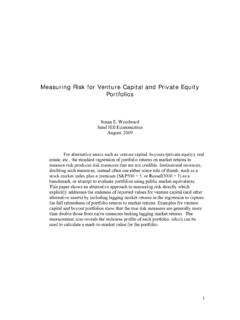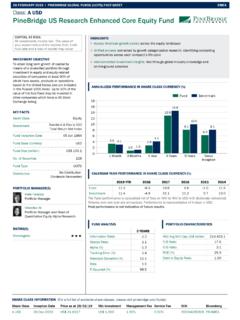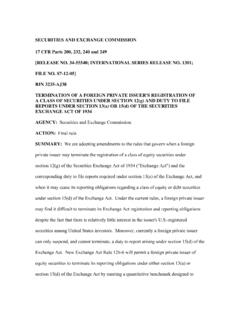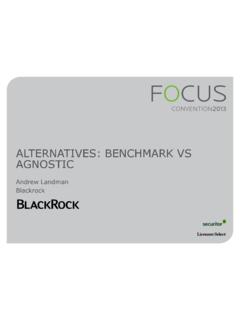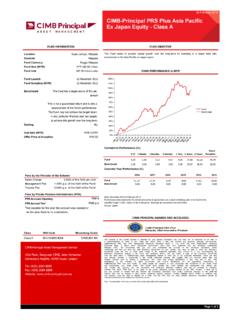Transcription of Portfolio Performance Evaluation
1 Foundations and Trends R. in Finance Vol. 2, No. 2 (2006) 83 190.. c 2007 G. O. Argon and W. E. Ferson DOI: Portfolio Performance Evaluation George O. Aragon1 and Wayne E. Ferson2. 1. Carey School of Business, Arizona State University, PO Box 873906, Tempe, AZ (480) 965-5810, 2. Marshall School of Business, University of Southern California, 701 Exposition Boulevard, Los Angeles, CA 90089-142, fersonwa Abstract This paper provides a review of the methods for measuring portfo- lio Performance and the evidence on the Performance of profession- ally managed investment portfolios. Traditional Performance measures, strongly in uenced by the Capital Asset Pricing Model of Sharpe (1964), were developed prior to 1990. We discuss some of the prop- erties and important problems associated with these measures. We then review the more recent Conditional Performance Evaluation tech- niques, designed to allow for expected returns and risks that may vary over time, and thus addressing one major shortcoming of the traditional measures.
2 We also discuss weight-based Performance measures and the stochastic discount factor approach. We review the evidence that these newer measures have produced on selectivity and market timing abil- ity for professional managed investment funds. The evidence includes equity style mutual funds, pension funds, asset allocation style funds, xed income funds and hedge funds. Keywords: Portfolio Performance ; mutual fund Performance ; hedge funds; managed portfolios. 1. Introduction This is a good time for a review of the academic literature on evaluating Portfolio Performance , concentrating on professionally managed invest- ment portfolios. While the literature goes back to before the 1960s, recent years have witnessed an explosion of new methods for perfor- mance Evaluation and new evidence on the subject. We think that several forces have contributed to this renaissance. The demand for research on managed Portfolio Performance increased as mutual funds and related investment vehicles became more important to investors in the 1980s and 1990s.
3 During this period, equity investment became widely popular, as 401(k) and other de ned-contribution investment plans began to dominate de ned-bene t plans in the United States. Under such plans, individuals make their own investment choices from a menu of employer-speci ed options. At the same time, baby- boomers reached an age where they had more money to invest, and new investment opportunities were developing for investors in Europe and Asia that increased the demand for professionally man- aged Portfolio products. This period also witnessed an explosive growth in alternative investments, such as hedge funds and private equity vehicles. 85. 86 Introduction While the demand for research on investment Performance has increased, the cost of producing this research has declined. Early studies relied on proprietary or expensive commercial databases for their fund Performance gures, or researchers collected data by hand from published paper volumes.
4 In 1997, the Center for Research in Security Prices introduced the CRSP mutual fund database, com- piled originally by Mark Carhart, into the academic research market. Starting in about 1994, several databases on hedge fund returns and characteristics became available to academic researchers. Of course, during the same period the costs of computing have declined dra- matically. In response to an increased demand and lower costs of production, the supply of research on fund Performance expanded dramatically. This chapter provides a selective review of the methods for mea- suring Portfolio Performance and the evidence on the Performance of professionally managed investment portfolios. As the relevant literature is vast and expanding quickly, a complete survey is virtually impossible. This one re ects its authors' interests, and no doubt, biases. Chapter 2 reviews the classical measures of Portfolio Performance developed between about 1960 and 1990.
5 Our review emphasizes a uni- fying theme. We measure the total Performance by comparing the returns on the managed Portfolio to the returns of an Otherwise Equivalent (our terminology) benchmark Portfolio . This is a portfo- lio with the same risk and other relevant characteristics as the man- aged Portfolio , but which does not re ect the manager's investment ability. A manager with investment ability generates higher returns than the otherwise equivalent alternative, at least before fees and costs are considered. We rst present the traditional measures, then review the important problems and properties associated with these measures. Early studies frequently attempt to distinguish security selection versus market timing abilities on the part of fund managers. Timing ability is the ability to use superior information about the future real- izations of common factors that a ect overall market returns.
6 A man- ager with timing ability may alter the asset allocation between stocks and safe assets or among other broad asset classes. Selectivity refers to 87. the use of security-speci c information, such as the ability to pick win- ning stocks or bonds within an asset class. We develop this dichotomy and discuss the ability of various Performance measures to capture it. This section closes with a review of the evidence for managed port- folio Performance based on the traditional measures. This discussion touches on the issues of survivorship bias and persistence in perfor- mance, among other topics. Chapter 3 discusses Conditional Performance Evaluation . Here, the idea is to measure Performance accounting for the fact that the expected returns and risks for investing may vary over time depend- ing on the state of the economy. An example motivates the approach. We then discuss simple modi cations to the traditional measures that attempt to condition on the state of the economy by using lagged vari- ables as instruments.
7 Chapter 4 discusses the Stochastic Discount Factor Approach to Performance measurement. We show brie y how this is related to the traditional alpha, what advantages the approach may have, and some recent developments. Chapter 5 summarizes and illustrates the main issues in implement- ing the Performance measures using hypothetical numerical examples. The examples are from the perspective of a fund-of-fund that must evaluate the Performance of a sample of hedge funds using historical returns data. Chapter 6 presents a brief discussion of the measures for invest- ment Performance of xed income funds and Chapter 7 discusses hedge funds. Research on these fund types is still in an early stage of devel- opment, and these types of funds seem to present unique challenges for measuring risk-adjusted Performance and for interpreting Performance measures. In Chapter 8, we review the modern empirical evidence on fund per- formance, which begins in about 1995 when studies began to use the CRSP-Carhart mutual fund database.
8 We review the evidence that con- ditional measures have produced, both on selectivity and market timing ability. Also, in the mid-1990s data on hedge fund returns and charac- teristics rst became available to academic researchers. We include a review of the evidence on hedge-fund Performance . 88 Introduction Chapter 9 provides tabular summaries of the historical evidence on the Performance of mutual funds and hedge funds using actual data. We describe how this evidence is related to the classical question of the informational e ciency of the markets. The various Performance measures are interpreted by using and referring back to the concepts developed earlier in the text and Chapter 10 is the conclusion. 2. Classical Measures of Portfolio Performance This chapter provides an overview of the classical measures of risk- adjusted Portfolio Performance . We rst describe the general logic that lies behind all of the measures, and then de ne the individual mea- sures.
9 We then discuss the theoretical properties of the measures in more detail. Finally, we look at empirical estimation of the measures on actual managed portfolios, and review the empirical evidence based on the classical measures. The Measures: An Overview The main idea in most of the classical measures of investment perfor- mance is quite simple. The measures essentially compare the return of a managed Portfolio over some Evaluation period to the return of a benchmark Portfolio . The benchmark Portfolio should represent a fea- sible investment alternative to the managed Portfolio being evaluated. If the objective is to evaluate the investment ability of the Portfolio manager or management company, as has typically been the case, the benchmark should represent an investment alternative that is equiv- alent, in all return-relevant aspects, to the managed Portfolio being 89. 90 Classical Measures of Portfolio Performance evaluated, except that it should not re ect the investment ability of the manager.
10 Let us call such a Portfolio an Otherwise Equivalent . (OE) benchmark Portfolio . An OE benchmark Portfolio requires that all of the Portfolio characteristics that imply di erences in expected returns are the same for the fund being evaluated and for the bench- mark. The problem in practice is to operationalize this idea. Most of the available measures of Portfolio Performance may be understood in terms of their de nitions of the OE benchmark. In order to operationalize the concept of an OE benchmark, it is necessary to have some model for what aspects of a Portfolio should lead to higher or lower expected returns. That is, some asset pricing model is For this reason, Portfolio Performance measures and asset pricing models are inextricably linked, and the development of Portfolio Performance measures in the literature mirrors the develop- ment of empirical asset pricing models.



